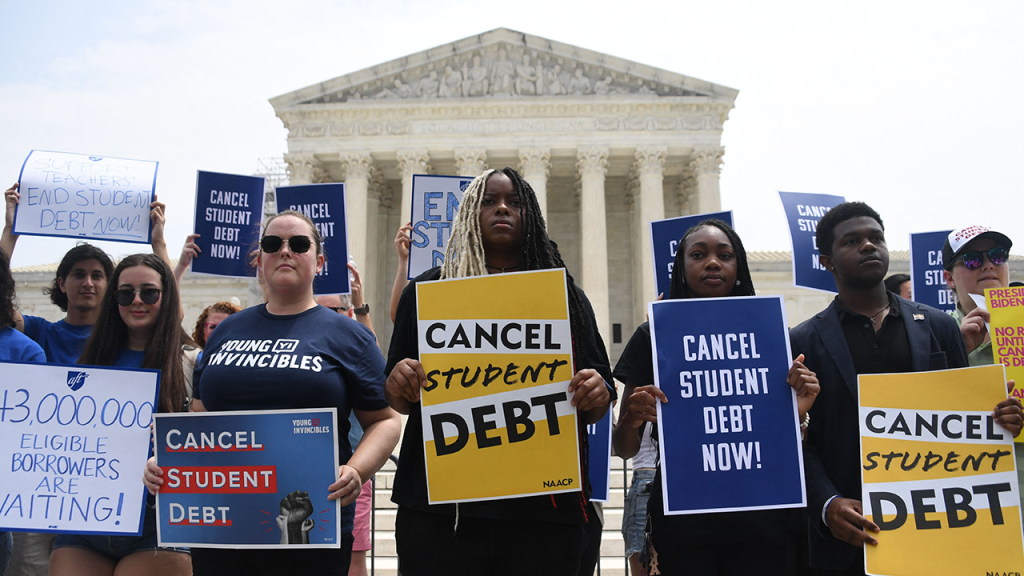The Biden administration’s efforts to implement student loan forgiveness programs have drawn renewed scrutiny as the White House announces stringent measures to reclaim debts owed by federal student loan borrowers. White House officials set forth a plan that would permit the garnishment of wages, pensions, and tax refunds from individuals who default on their loans, pushing back against taxpayer burdens created by unpaid student debts. The initiative, amid a high rate of delinquency among borrowers, marks a significant shift in the administration’s approach to managing the national student loan liability.
| Article Subheadings |
|---|
| 1) Overview of Student Loan Forgiveness and Default Rates |
| 2) Government’s New Enforcement Approach |
| 3) Implications for Borrowers and Taxpayers |
| 4) Political Reactions and Policy Responses |
| 5) The Future of Student Debt Management |
Overview of Student Loan Forgiveness and Default Rates
Federal student loan debt in the United States has reached an astronomical figure of around $1.6 trillion, with alarming statistics revealing a significant portion of borrowers struggling to make their payments. According to recent data, less than 40% of borrowers are in good standing concerning their loans, indicating a crisis in student debt repayment. As the Biden administration aimed to alleviate this burden through debt forgiveness initiatives, the ongoing challenges have led to an increasing number of individuals falling into default. Indeed, the Department of Education reported that nearly four million borrowers are classified as being in late-stage delinquency, indicating a serious threat to their financial futures and a burden on the economy.
Government’s New Enforcement Approach
In a decisive move, White House officials, led by press secretary Karoline Leavitt, announced that the administration plans to actively pursue those who have defaulted on their federal student loans. During a recent press briefing, Leavitt stated that the government would leverage various methods to recoup unpaid debts. This includes garnishing wages, withholding federal tax refunds, and claiming federal pensions for individuals who fail to repay their loans. The planned resumption of collection activities in May marks a notable shift from the payment pause implemented during the COVID-19 pandemic.
Implications for Borrowers and Taxpayers
The announcement has raised alarms among student loan borrowers, particularly those already facing financial hardships. The potential for wage garnishment and other financial penalties could exacerbate their economic struggles, particularly for those who may have relied on temporary relief measures in past months. Moreover, the White House’s stance emphasizes the principle that taxpayers should not be held responsible for others’ debts, framing the student loan crisis as an unsustainable burden on non-borrowers.
Political Reactions and Policy Responses
The administration’s decision to clamp down on student loan defaults has garnered a mixed response from policymakers and advocacy groups. Critics argue that the aggressive measures could disproportionately affect low-income borrowers and perpetuate cycles of poverty while supporters believe it holds borrowers accountable for their financial commitments. Linda McMahon, Secretary of Education, clarified the administration’s position, stating, “American taxpayers will no longer be forced to serve as collateral for irresponsible student loan policies.” This highlights the continuing debate on the government’s role in education funding and student debt management.
The Future of Student Debt Management
Looking ahead, the future of student debt management remains uncertain. With political contention surrounding borrower protections and student loan forgiveness policies, the administration’s new approach will likely initiate broader discussions on educational funding and debt relief systems. Potential reforms may emerge as legislators respond to shifting borrower needs and economic realities. Continued pressure from advocacy groups seeking comprehensive reforms may lead to changes in student loan policies, emphasizing the need for sustainable solutions.
| No. | Key Points |
|---|---|
| 1 | The federal student loan debt in the U.S. has reached approximately $1.6 trillion. |
| 2 | Less than 40% of borrowers are currently making timely payments on their student loans. |
| 3 | The Biden administration announced a plan to garnish wages and tax refunds for defaulted loans. |
| 4 | The decision aims to reduce the burden of unpaid loans on taxpayers. |
| 5 | Political reactions are divided, with advocates calling for borrower protections and reform. |
Summary
The Biden administration’s recent initiative to enforce repayment measures for federal student loans underscores a shift in how the government addresses the increasing crisis of student debt. As more borrowers fall into default, the implications of these policies will likely resonate across the economic landscape, sparking debate about borrower responsibility, taxpayer implications, and the trajectory of education financing in America. The landscape of student loan management is poised for significant scrutiny and potential reformation in the coming months.
Frequently Asked Questions
Question: What options are available for borrowers in default?
Borrowers may consider options such as loan rehabilitation, consolidation, or seeking forbearance, but it is crucial to communicate with their loan servicer to explore the most suitable solutions.
Question: How does garnishing wages affect borrowers?
Garnishing wages means that the federal government can divert a portion of a borrower’s paycheck to repay defaulted student loans, making it challenging for individuals to meet other financial obligations.
Question: What does the government plan to achieve with these measures?
The government aims to recover unpaid student loans while alleviating the financial burden on taxpayers, ensuring that borrowers are accountable for their obligations.


